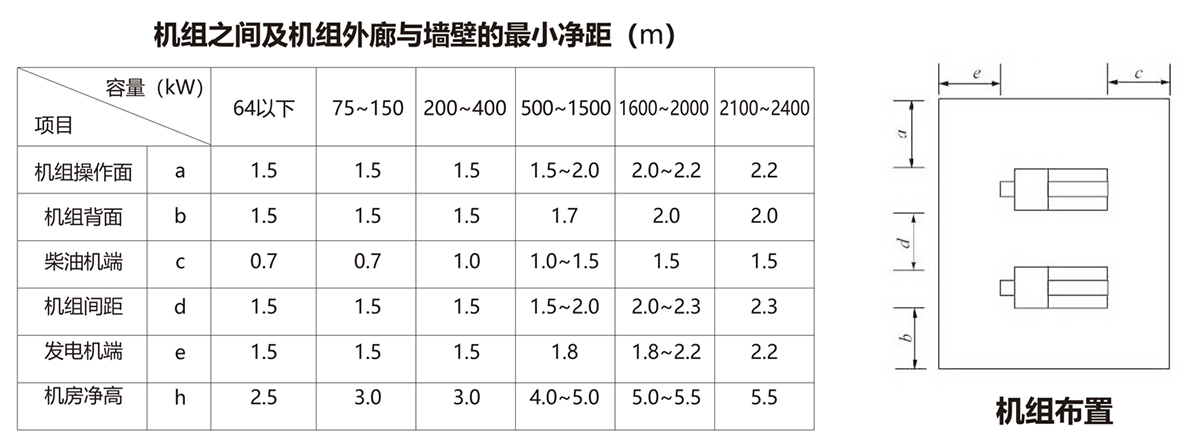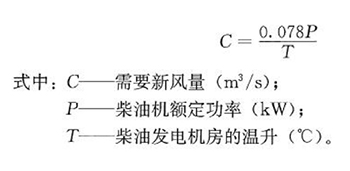1. Design of the machine room for self-contained emergency and standby diesel generator sets:
1. The machine room should be arranged on the first floor, basement, and podium roof of the building. When the basement is three floors or more, it should not be set on the lowest floor and should be set close to the substation.
The machine room should be arranged against the outer wall of the building, and should have ventilation, moisture-proof, smoke exhaust, noise reduction and vibration reduction measures for the unit and meet environmental protection requirements.
2. The machine room should have a generator room, control room and distribution room, oil storage room, spare parts storage room, etc. When the single unit capacity of the generator set is not more than 1000kW or the total capacity is not more than 1200kW, the generator room, control room and distribution room can be combined in the same room.
3. The capacity and number of units should be determined based on comprehensive factors such as the size of the emergency or standby load and the maximum starting capacity of a single motor. When the emergency or standby load is large, multiple units can be operated in parallel. The number of emergency diesel generator sets should not exceed 4, and the number of standby diesel generator sets should not exceed 7. The total capacity of units with a rated voltage of 230V/400V after parallel operation should not exceed 3000kW. When the conditions for parallel operation are limited, power supply can be implemented in different areas.
4. When the area of the machine room is 50m2 or less, it is advisable to set up at least one entrance and exit. When the area of the machine room is 50m2 or the length is more than 7 meters, it is advisable to set up at least two entrances and exits, one of which should meet the needs of transporting the unit; the doors and observation windows between the generator room and the control room and the distribution room should take fire prevention and sound insulation measures, and the doors should be Class A fire doors and should open to the generator room.
5. The layout of the equipment in the machine room should meet the requirements of the unit operation process: 1) The unit should be arranged horizontally; 2) When the machine room is arranged adjacent to the control room and the distribution room, the generator outlet and the cable trench should be arranged on the side close to the control room and the distribution room; 3) The net distance between the units and from the unit corridor to the wall should meet the needs of equipment transportation, on-site operation, maintenance and repair or the arrangement of auxiliary equipment.

Note: When the unit is designed for water cooling, the distance at the diesel engine end can be appropriately reduced; when the unit needs to be silenced, the size should be considered separately.
II. Design of the air inlet and exhaust (hot) vents in the machine room:
1. The air inlet of the machine room should be located directly opposite the generator end or on both sides of the generator end. The air inlet area should not be less than 1.6 times the area of the diesel engine radiator; the natural air inlet area should be greater than 1.25 times the air outlet area.
2. The hot air outlet should be close to the diesel engine radiator; the hot air pipe and the diesel engine radiator should be connected with a flexible joint; the area of the hot air outlet should not be less than 1.5 times the area of the diesel engine radiator; the hot air outlet should not be located on the side of the dominant wind direction. When there are difficulties, a windbreak wall should be added. 3. When the unit is located in the basement and the hot air duct cannot be laid straight, the number of hot air duct elbows should not exceed two, and the resistance loss of the duct should be calculated.
Three, pay special attention to the reasonable coordination of fresh air volume and exhaust volume, as well as the impact on environmental noise.
When the diesel generator is running, the ventilation volume of the machine room should be equal to or greater than the sum of the fresh air volume used to maintain diesel engine combustion and the fresh air volume required to maintain the temperature of the machine room. According to relevant foreign data, the amount of fresh air required to maintain the temperature of the machine room can be determined by the following formula:

The amount of fresh air required to maintain diesel engine combustion can be obtained from the diesel engine manufacturer. When the altitude increases, the air volume should increase by 10% for every 763m increase. If there is no data, it can be estimated that 0.1m3/min is required for 1kW braking power.
Fourth, the laying of the unit exhaust pipe:
1) The exhaust pipe of each diesel engine should be led to the exhaust duct separately, and it is advisable to lay it overhead or in the trench; the exhaust pipe should not have too many elbows and can move freely; the horizontal exhaust pipe should have a slope of 0.3%~0.5% to the exhaust duct, and a drain valve should be installed at the lowest point of the exhaust pipe; 2) When the indoor part of the exhaust pipe is laid overhead, a heat insulation protective layer should be laid; 3) The exhaust pressure of the unit should not exceed the back pressure requirement of the diesel engine. When the exhaust pipe is When the exhaust pipe is too long, a natural compensation section should be used and the diameter of the exhaust pipe should be increased; when there is no condition to set a natural compensation section, a compensator should be installed; 4) An elastic bellows should be installed at the connection between the exhaust pipe and the diesel engine exhaust port; 5) The exhaust pipe should be covered with a protective cover when passing through the wall, and a rain cap should be installed at the outlet when it extends out of the roof; 6) Non-supercharged diesel engines should be equipped with a muffler on the exhaust pipe; two diesel engines should not share a muffler, and the muffler should be fixed separately.
V. Relevant regulations on fire protection acceptance of oil storage room in diesel power generation room.
1. The diesel generator room should be separated from other parts by a partition wall with a fire resistance limit of not less than 2.00h and a floor with a fire resistance limit of 1.50h
2. The soft connection between the heat sink and the exhaust port of the generator set should be installed with fireproof cloth with sufficient fire resistance.
3. An independent oil storage room should be set up in the machine room, with an oil tank capacity of ≤1M3 and an oil storage capacity not exceeding 8 hours of demand.
4. The oil storage room should be covered with 10 cm thick fine sand to prevent oil leakage. The specific height is calculated according to the area of the oil storage room and the volume of the oil tank.
5. A vent pipe extending to the outdoors should be installed on the oil tank, with a breathing valve (with a flame arrester) at the end, and sometimes a rain cap should be added.
Six, self-starting and parallel operation of generator sets:
1. Generator sets used for emergency power supply should be in a self-starting state at ordinary times. When the city power is interrupted, the low-voltage generator set should supply power within 30s, and the high-voltage generator set should supply power within 60s;
2. The power supply of the unit shall not be parallel to the city power, and there shall be an interlocking device to prevent the wrong connection to the grid:
3. When the city power is restored to normal power supply, it shall be able to automatically switch to the normal power supply, the unit shall automatically exit the work, and delay the shutdown
4. In order to avoid the diesel generator set being shut down due to the simultaneous start of the motors of the disaster prevention electrical equipment, the electrical equipment shall have different delays and staggered start times;
5. When the importance is the same, it is advisable to start the load with large capacity first.
Seven, wiring method of self-start signal line:
1. Generally taken from the auxiliary contact of the main switch of the main power supply;
2. Pick up the voltage start signal from the upper port of the switch at the output end of the transformer;
3. Use the PLC programmable controller of the switch to send out the signal;
4. If there are two transformers, install an intermediate relay on each of the two main cabinets. Their standing contacts are connected in series with the starting circuit of the generator 4. After the main power is cut off, the standing contacts of the intermediate relay are closed to send out the start signal.
5. The self-start signal line can be connected to active signals or passive signals. Active signals are convenient and do not need to pull new charging cables. The signal line specifications are generally RVV-2*1.5mm?.
Eight, machine room grounding system:
1. The neutral point working system of 1kV and below generator sets shall comply with the following provisions:
1) When there is only one unit, the neutral point of the generator shall be directly grounded, and the grounding form of the unit shall be consistent with the grounding form of the low-voltage distribution system.
2) When multiple units are running in parallel, the neutral point of each unit shall be grounded through a knife switch or contactor.
2. The grounding method of 3kV~10kV generator sets should adopt the neutral point grounding through low resistance or no grounding method; in the system with low resistance grounding, when multiple generator sets are running in parallel, each unit should be equipped with a grounding resistor.
3. The grounding and communication of the diesel generator room should comply with the following regulations:
1) The grounding in the machine room should adopt common grounding;
2) The equipment and pipelines of the fuel system should take anti-static grounding measures;
3) The control room and the duty room should be equipped with communication telephones, and a special fire telephone extension should be set up.



 Service Hotline:+86-0757-29990133
Service Hotline:+86-0757-29990133